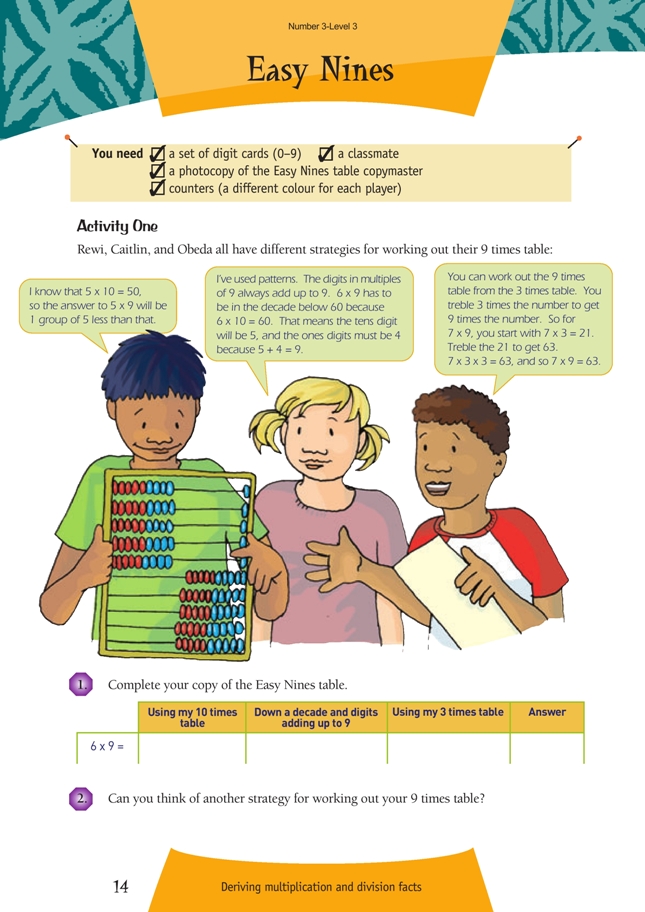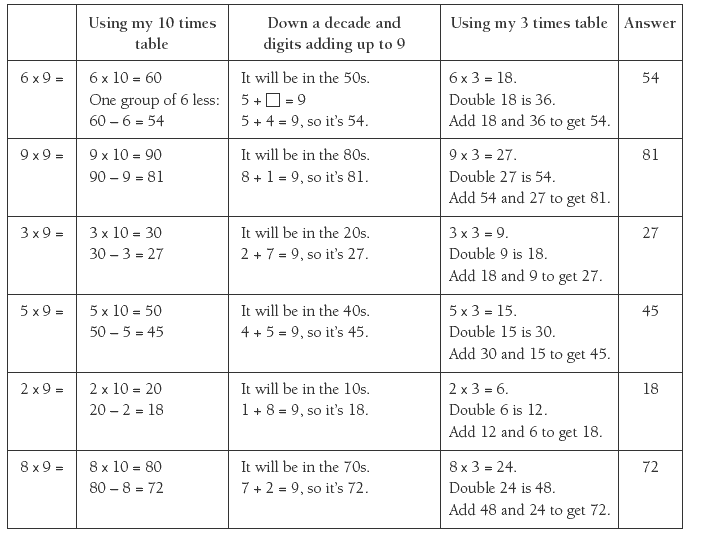This is a level 3 number activity from the Figure It Out series. It relates to Stage 6 of the Number Framework.
A PDF of the student activity is included.
Click on the image to enlarge it. Click again to close. Download PDF (323 KB)
solve nine times tables problems
- Numeral cards
- Easy Nines table copymaster
- FIO, Level 3, Number, Book 3, Easy Nines, pages 14-15
- Counters
- A classmate
Activities One and Two
In these activities, students use their addition skills, explore the relationship between multiplication and division, use known facts to derive unknown ones, and show their understanding of multiplication as repeated addition.
These activities explore three methods for solving problems involving multiplying by 9. The 9 times table is often hard for students because it is usually the last to be introduced. Although the students have learned all the facts in the 9 times table in earlier tables (apart from 9 x 9, which they may have met through an exploration of square numbers), they often do not make these connections (for example, that 3 x 9 is the same as 9 x 3). Moreover, not enough time may have been allocated
to memorising and maintaining this last times table.
Each of these strategies needs to be explored so that the students can call on one of them when they “forget” a basic fact or when they need to extend to larger numbers, such as 18 x 9.
Activity One, question 1 asks the students to complete their copy of the Easy Nines table (see the copymaster at the end of these notes), using the three methods explained on the page. Some students may need assistance in understanding each of the methods, especially if their recall of tables is not strong.
Question 2 asks the students if they can think of another strategy to solve the problems. The students may come up with several strategies. You may wish to explore these with the students as a group or class and then compare the effectiveness of each of the strategies. One strategy is to divide a number by 3 and then by 3 again to find the answer to a 9 times table fact.
81 ÷ 3 ÷ 3 = 9, and so 9 x 9 = 81.
Activity Two starts with a game using the 9 times table. To be efficient, the students should have a good recall of the 9 times table. If they don’t, you could allow them to write out the 9 times table up to 9 times 10 and refer to it as they play the game. This will enable them to practise and familiarise themselves with the 9 times table in a fun environment.
In question 2, the students need to use their knowledge and strategies to solve various problems. At first, the students may not see how they can use the 9 times table to help them with some of the problems, and they may revert to other methods. Some possible strategies are given in the Answers. The students may also come up with other possible strategies that may not necessarily involve using the 9 times table. For example, 50 x 8 – 8 is a more efficient way to solve 49 x 8 than 40 x 8 + 9 x 8 or 40 x 9 + 9 x 9 – 49.
Answers to Activities
Activity One.
1.
2. Answers will vary. One possible strategy is to use doubling. For example, for 7 x 9, double the 7 three times and then add 1 more group of 7:
7 x 2 = 14
14 x 2 = 28
28 x 2 = 56
56 + 7 = 63
(7 x 9 = 63)
Activity Two
1. A game for practising the 9 times strategies
2. a. 36
b. 63
c. 90
Answers for d–i and some possible strategies using the 9 times table are:
d. 95. (19 x 5 is the same as 9 x 5 plus 10 x 5.)
e. 392. (49 x 8 is the same as 40 x 8 plus 9 x 8.)
f. 174. (29 x 6 is the same as 20 x 6 plus 9 x 6.)
g. 9. (81 ÷ 9 = is the same as 9 x = 81.)
h. 7. (63 ÷ 9 = is the same as x 9 = 63.)
i. 54. ( ÷ 9 = 6 is the same as 6 x 9 = .)


